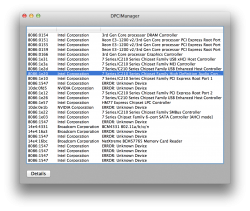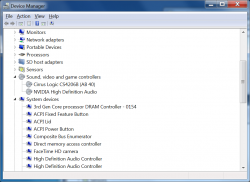EDIT: The thread below seems to be only an issue for EFI installs of Windows 8 RTM.
I can't get audio working on my rMBP on Windows 8 RTM x64 after installing bootcamp drivers.
In device manager I get one working "High Definition Audio Controller" and one non functional. I think the functional is for the HDMI audio. The non-functional has the following properties...
Location: PCI bus 0, device 27, function 0
Driver Provider: Microsoft
Driver Date: 7/25/2012
Driver Version: 6.2.9200.16384
Digital Signer: Microsoft Windows
and reports the following events...
Device PCI\VEN_8086&DEV_1E20&SUBSYS_72708086&REV_04\3&11583659&0&D8 had a problem starting.
Driver Name: hdaudbus.inf
I have tried the following:
removing and deleting the current driver (always reinstalls)
reinstalling the realtek driver from the bootcamp disk (doesn't take)
I notice that the usetup.iss file from the realtek folder that book camp leaves lists the following entry...
Name=Realtek High Definition Audio Driver
Version=2.49
...but theRtlUpd64.exe file property details list the product version as 2,8,0,6 with a modified date of 5/4/2012.
...and the website from which I downloaded them lists them as 2.70 (http://218.210.127.131/downloads/do...=24&Level=4&Conn=3&DownTypeID=3&GetDown=false)
Autoupdate won't replace the driver. I could try to manually install the driver but there are 42 inf files in the Realtek High Definition Audio Controller file I downloaded, none of which are called hdaudbus.inf.
I tried deleting all the entries of hdaudbus.inf but TrustedInstaller won't let me delete the copy in WinSxS.
Any ideas? Anyone else have this working? Any chance this is an Intel C216 audio controller and if so, why would the realtek drivers be included or get installed at all?
I can't get audio working on my rMBP on Windows 8 RTM x64 after installing bootcamp drivers.
In device manager I get one working "High Definition Audio Controller" and one non functional. I think the functional is for the HDMI audio. The non-functional has the following properties...
Location: PCI bus 0, device 27, function 0
Driver Provider: Microsoft
Driver Date: 7/25/2012
Driver Version: 6.2.9200.16384
Digital Signer: Microsoft Windows
and reports the following events...
Device PCI\VEN_8086&DEV_1E20&SUBSYS_72708086&REV_04\3&11583659&0&D8 had a problem starting.
Driver Name: hdaudbus.inf
I have tried the following:
removing and deleting the current driver (always reinstalls)
reinstalling the realtek driver from the bootcamp disk (doesn't take)
I notice that the usetup.iss file from the realtek folder that book camp leaves lists the following entry...
Name=Realtek High Definition Audio Driver
Version=2.49
...but theRtlUpd64.exe file property details list the product version as 2,8,0,6 with a modified date of 5/4/2012.
...and the website from which I downloaded them lists them as 2.70 (http://218.210.127.131/downloads/do...=24&Level=4&Conn=3&DownTypeID=3&GetDown=false)
Autoupdate won't replace the driver. I could try to manually install the driver but there are 42 inf files in the Realtek High Definition Audio Controller file I downloaded, none of which are called hdaudbus.inf.
I tried deleting all the entries of hdaudbus.inf but TrustedInstaller won't let me delete the copy in WinSxS.
Any ideas? Anyone else have this working? Any chance this is an Intel C216 audio controller and if so, why would the realtek drivers be included or get installed at all?
Last edited:



